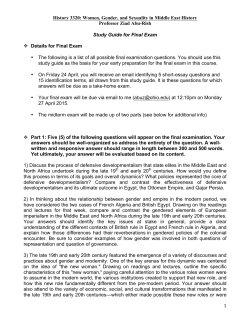
CS 148: Introduction to Computer Graphics and Imaging
CS 148: Introduction to Computer Graphics and Imaging Creative Expression (CE) WAYS course Instructor: Ron Fedkiw Website: cs148.stanford.edu Meeting Times: Tuesday and Thursday, 9:30am to 10:45am 1/26 What can I do with graphics? 2/26 Visual Effects: Liquids Battleship Terminator 2 The Day After Tomorrow 3/26 Visual Effects: Gases Harry Potter and the Order of the Phoenix Terminator 3 Star Wars Episode III 4/26 Visual Effects: Solids • Destruction: fracture, explosions, etc Super 8 2012 5/26 Visual Effects: Digital Doubles The Curious Case of Benjamin Button 6/26 Visual Effects: CG Creatures Yoda, Star Wars Episode II Sméagol/Gollum, The Lord of the Rings 7/26 Motion Capture Facial capture in Avatar Motion capture of Olympic swimmer Dana Vollmer by Manhattan Mocap 8/26 Animated Films Toy Story 3 Monsters, Inc. 9/26 Video Games Spore Crysis Braid 10/26 What can I do with graphics? 11/26 2D Image Processing 12/26 Computer-Aided Design Sketchup ProEngineer 13/26 Scientific Visualization The Virtual Human Karl-Heinz Hoehne Outside-In The Geometry Center 14/26 Visual Simulation and Training • • • • Apollo spacecraft Flight simulators Driving simulators Surgical simulation Davinci surgical robot Intuitive Surgical Driving simulator Toyota Higashifuji Technical Center 15/26 Digital Media Technologies – – – – – Digital photography Inkjet and laser printers Digital video and HDTV Electronic books Graphics on the web: Sony Video Camera • Photos (flickr) • Videos (youtube) Apple Laserwriter 16/26 User Interfaces Apple iPad Ivan Sutherland, Sketchpad, Light-pen, vector display Console Controller 17/26 Virtual Reality • Immersive interfaces – Input: 3D 6-DOF tracking, gloves – Output: Head-mounted and projection displays Ivan Sutherland: Headmounted displays, with mechanical tracker Oculus Rift 18/26 Graphics Hardware NVIDIA Fermi NVIDIA OptiX 19/26 Cameras and Smartphones • Sales of smartphones outweigh sales of cameras by a factor of 3 • Most smartphones have cameras • 5 billion mobile phones are in use worldwide • 4.4 billion camera phones and 1.2 billion smartphones • World population is 7 billion 20/26 Overview of the Graphics Track Creative Expression (CE) WAYS course 1. CS 148 (core class) A. Using the computer to draw pictures B. Theoretical background (math/physics) for the technical aspects of drawing pictures C. Coding: You will write code but will not submit any code. Instead, you will show your pictures via live demos. 21/26 Overview of the Graphics Track 2. CS 248 (creating a videogame) A. Now that you know how to draw a picture (CS 148), we cover many other aspects of graphics using the specific example of a video game B. Topics include: Platforms, game design, artificial intelligence, UIs/GUIs, computational geometry, computer animation, simulation, etc. C. You may write a 2D game if your game is a mobile or web game – This doesn’t stress rendering which is the topic of CS 148 but covers everything else. 22/26 Overview of the Graphics Track 3. Other Courses A. B. C. D. E. F. G. H. I. Rendering CS 348B Special Topics: CS 448 Cameras: CS 178, CS 478 Math: CS 205A, CME 102, CME 104, CME 108, MATH 113 Geometry: CS 164, CS 268, CS 348A, CS 468 Computer Vision: CS 231A, CS 231B Image Processing EE 368/CS 232 Robotics: CS 223A, CS 225A, CS 327A Mobile Devices: CS 193I, CS193P 23/26 CS 148 – 3 Milestones Scanline Render: Portal, Valve Corporation Raytraced Render: San Miguel Scene, PBRT Math and Optics 24/26 Assignments and Grading • Grading: 1/3 scanline image, 1/3 raytraced image, 1/3 optics take home exam/assignment Images: • The scanline and raytraced images will include a number of graded building block weekly assignments (6 of these in all) assigned every Tuesday and due the following Monday from 3-7pm graded on a check/plus/minus rubric. • The check/plus/minus grades will be incorporated into the final letter grade of for each image. – Don't be surprised that if your final image grade is lower than you expect, after getting minuses or missing grading sessions • You may use the same or a different partner for both images. Written Assignment: • You will have two weeks to complete the written assignment. • You may work in groups of up to 3 people but each person must hand in an independent write-up of their solutions. 25/26 Course Outline TUESDAY THURSDAY HOMEWORK Introduction Scanline Rendering HW 1: covers lecture 2 Geometric Modeling Shading HW 2: covers lectures 3 and 4 Texture Mapping More Texture Mapping HW 3: covers lectures 5 and 6 In-Class Demo In-Class Demo Scanline Image: covers lectures 2-6 Light & Optics 1 Light & Optics 2 Light & Optics 3 Light & Optics 4 Take Home Exam: covers 9-12 Ray Tracing Reflection and Transmission HW 4: covers lecture 13 and 14 Acceleration Structures Sampling HW 5: covers lecture 15 and 16 Advanced Rendering 1 Advanced Rendering 2 HW 6: covers lectures 17 and 18 Thanksgiving Recess Thanksgiving Recess In-Class Demo In-Class Demo Ray Traced Image: covers lectures 13-18 Final Exam: TBA • Arrange with the TA’s now if you need special consideration for scheduling of the In-Class Demos 26/26 How To Approach This Course • This is essentially a project based course • except for the middle 2 weeks on the optics assignment • Your goal is to explore digital image creation via various computer graphics techniques • The course is supposed to be fun! • It’s not supposed to be a programming course or math course, except that programming and math are necessary enabling technologies • The instructor and CAs are your guides • Lectures are meant to lead you in the right direction --- just to get your started • They are not meant to tell you everything • You should utilize the reference reading materials • You should utilize the CAs, your classmates, online resources, and your imagination… 27/26 Some of Last Year’s Images… 28/26 29/26 30/26 31/26 32/26 33/26 34/26 35/26 A 348B image… 36/26 37/26
© Copyright 2025





















